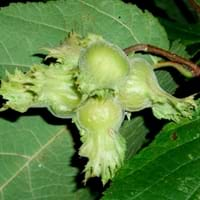Life Span
Perennial
Perennial
Type
Bulb or Corm or Tuber
Shrub
Origin
South America
North America, Northeastern United States, Mid-Atlantic United States, Southeastern United States, Canada
Types
Pamianthe cardenasii , Pamianthe parviflora , Pamianthe peruviana
Not Available
Number of Varieties
Not Available
Habitat
All sorts of environments
Mediterranean region
USDA Hardiness Zone
8-10
3-9
Sunset Zone
21,22
2b, 3a, 3b, 4, 5, 6, 7, 8, 9, 14, 15, 17, 18, 19, 20
Habit
Clump-Forming
Thicket/Colonizing
Flower Color
White
Yellow, Red
Flower Color Modifier
Bicolor
Not Available
Fruit Color
Green
Not Available
Leaf Color in Spring
Dark Green
Green, Light Green
Leaf Color in Summer
Light Green
Green, Dark Green
Leaf Color in Fall
Several shades of Green
Red, Dark Red, Copper
Leaf Color in Winter
Light Green
Not Available
Leaf Shape
Strap shaped
Heart-shaped
Plant Season
Spring, Summer, Fall
Spring, Summer, Fall
Sunlight
Partial Sun, Partial shade
Full Sun, Partial Sun, Partial shade
Type of Soil
Loam, Sand
Loam
The pH of Soil
Acidic, Neutral, Alkaline
Neutral, Alkaline
Soil Drainage
Average
Average
Bloom Time
Spring, Late Spring, Early Summer, Summer, Late Summer
Early Spring
Tolerances
Drought
Drought
Where to Plant?
Ground, Pot
Ground, Pot
How to Plant?
Offsets
Seedlings, Transplanting
Plant Maintenance
Medium
Medium
Watering Requirements
Keep the ground moist but not water-logged
Average Water Needs, Do Not over Water
In Summer
Lots of watering
Lots of watering
In Spring
Moderate
Moderate
In Winter
Average Water
Average Water
Soil pH
Acidic, Neutral, Alkaline
Neutral, Alkaline
Soil Type
Loam, Sand
Loam
Soil Drainage Capacity
Average
Average
Sun Exposure
Partial Sun, Partial shade
Full Sun, Partial Sun, Partial shade
Pruning
Pinch or prune as they grow to promote branching and bushiness, Remove damaged leaves, Remove dead branches, Remove dead leaves, Requires little pruning
Remove damaged leaves, Remove dead branches, Remove dead leaves
Fertilizers
All-Purpose Liquid Fertilizer, High phosphorus
All-Purpose Liquid Fertilizer
Pests and Diseases
Leaf spot, Mosaic viruses
Red blotch
Plant Tolerance
Drought
Drought
Flower Petal Number
Single
Not Available
Foliage Texture
Coarse
Medium
Foliage Sheen
Glossy
Matte
Attracts
Bees, Birds, Bumblebees, Butterflies, Hummingbirds, pollinators
Birds
Allergy
Unknown
Hay fever, Oral Allergy
Aesthetic Uses
Beautification, Bouquets, Ornamental use, Showy Purposes
Beautification, Showy Purposes
Beauty Benefits
No Beauty Benefits
Anti-ageing, Glowing Skin, Good for skin and hair, Skin cleanser
Environmental Uses
Air purification
Air purification
Medicinal Uses
No Medicinal Use
Astringent, Febrifuge
Part of Plant Used
Not Available
Bark, Leaves, Twigs
Other Uses
Beneficial species for attracting pollinators, Decoration Purposes
Used as Ornamental plant, Used for its medicinal properties
Used As Indoor Plant
No
Yes
Used As Outdoor Plant
Yes
Yes
Garden Design
Bog Garden, Container, Feature Plant, Foundation, Mixed Border, Water Gardens
Edible, Feature Plant, Foundation, Fruit, Fruit Tree, Mixed Border, Screening, Wind Break
Botanical Name
HYMENOCALLIS longipetala
CORYLUS americana
Common Name
Peruvian Daffodil, Spiderlily
American Hazelnut
In Hindi
peruvian daffodil
अमेरिकी हेज़लनट
In German
peruvian daffodil
amerikanische Haselnuss
In French
peruvian daffodil
américaine noisettes
In Spanish
Pamianthe
Americana avellana
In Greek
peruvian daffodil
American Hazelnut
In Portuguese
peruvian daffodil
americana avelã
In Polish
peruvian daffodil
Amerykański orzech laskowy
In Latin
peruvian daffodil
American Hazelnut
Phylum
Magnoliophyta
Magnoliophyta
Class
Liliopsida
Magnoliopsida
Order
Asparagales
Fagales
Family
Amaryllidaceae
Betulaceae
Clade
Angiosperms, Monocots
Angiosperms, Eudicots, Rosids
Tribe
Clinantheae
Coryleae
Subfamily
Amaryllidoideae
Coryloideae
Number of Species
Not Available
Not Available
Season and Care of Peruvian Daffodil and American Hazelnut
Season and care of Peruvian Daffodil and American Hazelnut is important to know. While considering everything about Peruvian Daffodil and American Hazelnut Care, growing season is an essential factor. Peruvian Daffodil season is Spring, Summer and Fall and American Hazelnut season is Spring, Summer and Fall. The type of soil for Peruvian Daffodil is Loam, Sand and for American Hazelnut is Loam while the PH of soil for Peruvian Daffodil is Acidic, Neutral, Alkaline and for American Hazelnut is Neutral, Alkaline.
Peruvian Daffodil and American Hazelnut Physical Information
Peruvian Daffodil and American Hazelnut physical information is very important for comparison. Peruvian Daffodil height is 61.00 cm and width 61.00 cm whereas American Hazelnut height is 300.00 cm and width 340.00 cm. The color specification of Peruvian Daffodil and American Hazelnut are as follows:
Peruvian Daffodil flower color: White
Peruvian Daffodil leaf color: Dark Green
American Hazelnut flower color: Yellow and Red
- American Hazelnut leaf color: Green and Light Green
Care of Peruvian Daffodil and American Hazelnut
Care of Peruvian Daffodil and American Hazelnut include pruning, fertilizers, watering etc. Peruvian Daffodil pruning is done Pinch or prune as they grow to promote branching and bushiness, Remove damaged leaves, Remove dead branches, Remove dead leaves and Requires little pruning and American Hazelnut pruning is done Remove damaged leaves, Remove dead branches and Remove dead leaves. In summer Peruvian Daffodil needs Lots of watering and in winter, it needs Average Water. Whereas, in summer American Hazelnut needs Lots of watering and in winter, it needs Average Water.





